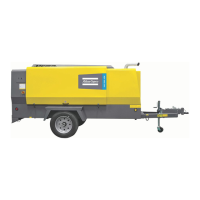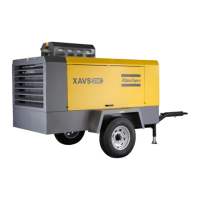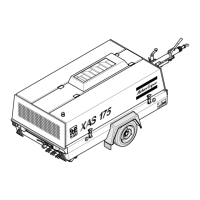- 59 -
FUEL FILTER REPLACEMENT
Engines are equipped with dual fuel filters: a primary filter
with water bowl, and a final filter. Both filters are replaced
at the same 500 hour interval or every 12 months.
Remove primary fuel filter element
1. Thoroughly clean filter header and surrounding area to
prevent dirt and debris from entering fuel system.
2. Connect a hose to filter drain valve (5) on bottom of
filter and drain all fuel from filter canister.
3. Disconnect water in fuel sensor connector (1).
4. Remove fuel filter canister (2).
5. Pull filter element (3) down.
Install primary fuel filter element
1. Place new O-ring (4) on filter canister.
2. Apply a thin film of fuel on O-ring.
Both the primary and the final fuel filter
elements must be replaced at the same time.
3. Place Filter Element in canister with tangs on bottom
going into canister.
4. Screw canister into filter header then tighten to
specification.
Remove final fuel filter element
1. Thoroughly clean filter header and surrounding area to
prevent dirt and debris from entering fuel system.
2. Connect a hose to filter drain valve (8) on bottom of
filter and drain all fuel from filter element.
3. Loosen and remove fuel filter element (6).
Install final fuel filter element
1. Place new filter packing (7) on filter element.
2. Apply a thin film of fuel on packing.
3. Screw filter element into fuel filter header (9) then
tighten to 10 N·m (7.5 lb.ft.).
To prime the fuel system, before starting
engine, turn ignition key to ON for 60 sec.
Fill the fuel tank at the end of each working
day to reduce condensation & moisture
build-up in the fuelsystem.
Replace fuel filter elements anytime audible
alarm sounds and trouble codes indicate
plugged fuel filters (low fuel pressure). If no
alarm sounds during the 12 month service
interval, replace elements at that time, or
after 500 hours operation, whichever comes
first.
Do not open higher pressure fuel system .
Escaping fluid under pressure can penetrate
the skin causing serious injury. Relieve
pressure before disconnecting fuel or other
lines. Tighten all connections before
applying pressure. Keep hands and body
away from pinholes and nozzles which eject
fluids under high pressure. Use a piece of
cardboard or paper to search for leaks. Do
not use your hand.
If any fluid is injected into the skin, it must
be surgically removed within a few hours by
a doctor familiar with this type injury or
gangrene may result.

